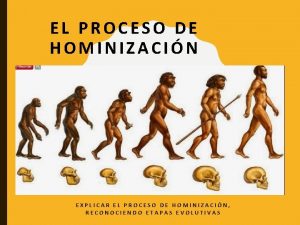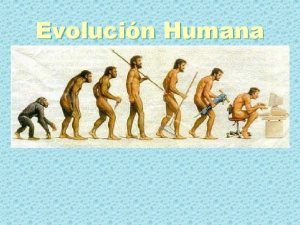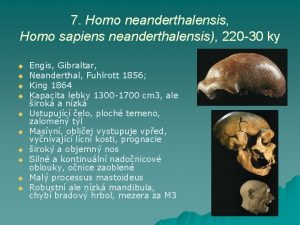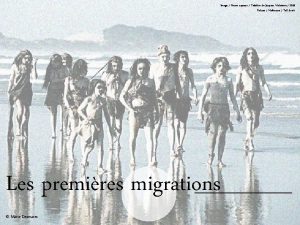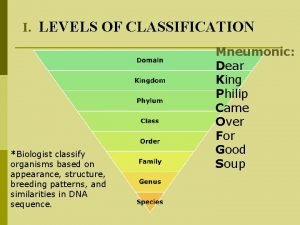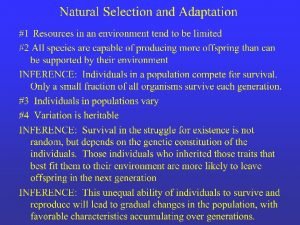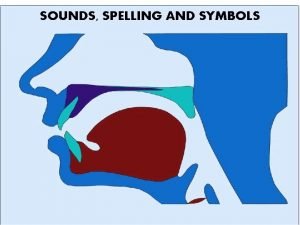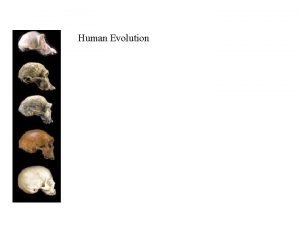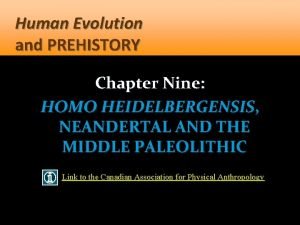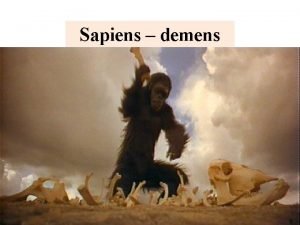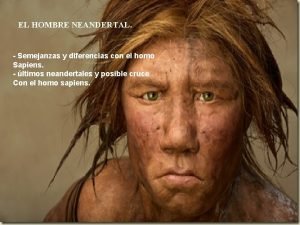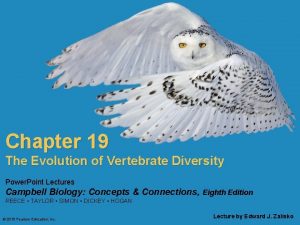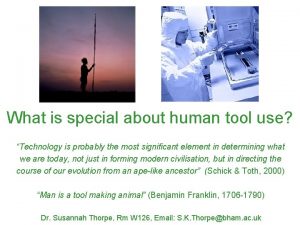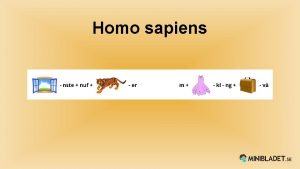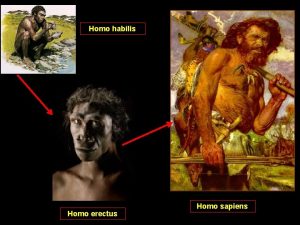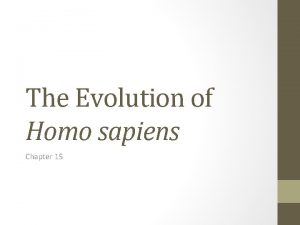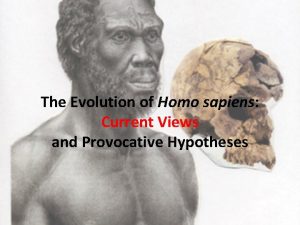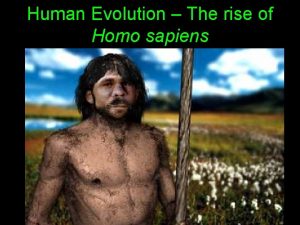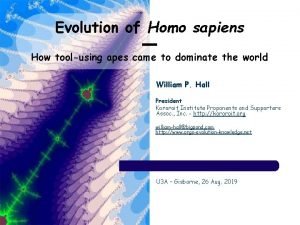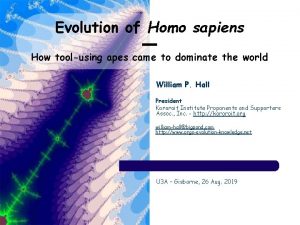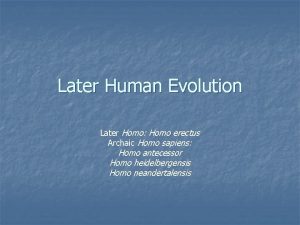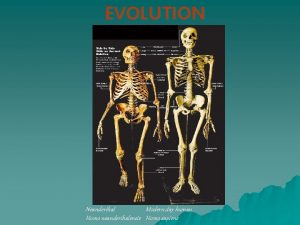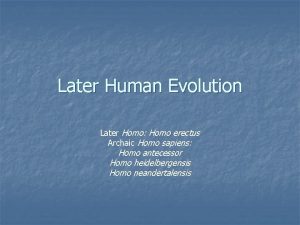From Hominin to Homo Sapiens The Evolution of































- Slides: 31

From Hominin to Homo Sapiens: The Evolution of our Family Tree

Hominoid to Hominin…Homo Sapiens What’s the difference? • When scientists characterize a creature as a hominin/hominid, what we mean is that they are classified with humans in the “tribe, ” Hominini. The tribe is a taxonomic unit between the family and the genus. Humans belong to the family Hominidea, which includes all of the great apes and the genus Homo.

Non-Human Primates: the Roots of Human Culture Primate Characteristics Size Varies from several ounces- to over 400 lbs. Facial Morphology Flat faces, reduced snouts in comparison to other mammals Hands 5 digits on hand feet; Opposable Thumbs that can grasp with both hands and feet Brains Large brain in comparison to their overall body size Growth rates Take much longer to mature than other mammals Extended developmental/ juvenile period Enculturation period(s) Most primates are highly social, provides a context for the social modeling of primate behavior Modern humans are closely related to the great apes with whom we share a LCA (Last Common Ancestor).

Non-Human Primates • Most primates live in low-altitude areas of the tropics or subtropics. ( A few species live in the higher altitudes of Africa, Nepal and Japan. ) • Most primate species are arboreal, quadrupedal and diurnal like humans. • Most primate species are highly social and prefer to live in groups and interacting with others of the same species. • Provide for their food needs via foraging or obtaining food available in nature through gathering, hunting or scavenging. • Species vary in terms of what food preferences they have: frugivores, folivores, insectivores, gumnivores, and omnivores.

Brachiation: Is the ability to swing (hand over hand) which assists in Vertical leaping and climbing. Brachiation is found amongst all primates including humans.

The Evolutionary Spark… Climate Change. Miocene Epoch (23 mya-5 mya) This geological epoch was important in that it was witness to extreme climatic changes both globally and specifically on the African continent. • During this time period the ambient temperature cooled. This cooling led to the proliferation of woodland/savanna and drastically limited the area of semi-tropical forests. The spread of woodland savanna led to the evolution of the first hominins approximately 7 -6 mya. • Approximately 7 -6 mya, hominins begin to appear in the fossil record. Between 4 -2 mya, the hominin lineage diversified into a community of several hominin species that ranged geographically from Eastern to Southern Africa.

Derived Traits that distinguish modern humans from contemporary Apes 1. We habitually walk upright (bipedalism) 2. Our dentition and jaw musculature are different from other of apes. Humans have a parabolic dental arcades, thick enamel, reduced canine teeth and larger molars in relation to their other teeth. 3. We have much larger brains in relation to our body size. 4. We develop slowly with a long juvenile period. 5. We depend on an elaborate, highly variable material and symbolic culture, transmitted in part through spoken language.

Evolution of Modern Homo…

Sahelanthropus tchadensis (7 mya-4. 9 mya) Discovered 2002, in Torros-Menalla Chad. Discoverer: Michel Brunet of University of Poitiers, France The Fossil consisted of a nearly complete cranium, 2 fragments of the lower mandible, and several teeth. The face is very flat, the foramen magnum is located at the base of the cranium and a massive brow ridge over the eye orbits. These are 3 features of much later (4 -2 mya) hominin species. On the other hand… It has a very small brain case only (320 cc-350 cc), the teeth are very primitive, and the back of the cranium is extremely ape-like

Sahelanthropus tchadensis

Orrorin tugenensis (6 mya- 4. 9 mya) Discovered: 2001, in Tugen Hills Kenya Discoverers: French-Kenyan team led by Brigitte Senut of National Museum of Natural History, Paris and Martin Pickford of the Kenya Paleontology Expedition. Fossil(s) consisted of 12 hominins. These fossils included parts of the thigh and arm bones, a finger bone, 2 partial mandibles, and several teeth. The incisors and canines look more chimpanzee-like. The arm and finger bones have features showing an adaptation for climbing. On the other hand… Tugenensis’ molars are much smaller than in A. Ramidus and have thick enamel similar to what we find in humans.

The fossils of Orrorin Tugenensis include-Parts of the femur, lower mandible, fingers and teeth

Ardipithecus (6 mya-4 mya) Discovered: 1992, Aramis in the Middle Awash Basin of Ethiopia south of Hadar. Discoverer: Team led by Dr. Timothy White of University of California, Berkeley. Fossil(s): First fossil dated to 4. 4 mya and subsequent fossils fell into range date of (5. 8 -5. 2 mya) and consisted of teeth, jaws, the lower part of the skull and parts of the upper arms. The genus Ardipithecus includes 2 species– A. ramidus and A. kadabba. Human-like vs. Chimp-like 1. )Has a foramen magnum located forward under the skull; this is generally associated with bipedalism. 2. )Fossil also contained small incisor-like canines that have not been sharpened by the lower premolars as found in chimpanzees. 3. ) Additional features of the teeth and upper arm bones are very human-like.

Ardipithecus 1. )Ardipithecus’ canines are fairly small in comparison to its overall body size. 2. ) Thin enamel layer on the teeth. 3. ) The deciduous molars and jaw joint are very similar to those of apes. 4. ) The base of the skull is more pneumatized (filled with air pockets) than in hominins. 90 more fossil specimens have be been recovered including – a pelvis, hand/foot bones, arm, leg and skull making up 45% of the overall skeleton. Johannes Haile-Selassie (a member of Tim White’s Team) Has since discovered an earlier fossil sub-species of Ardipithecus known as A. kadabba. A. Kadabba shows many features that are more ape-like and dates back earlier than A. ramidus.

Ardipithecus ramidus

Hominin community: Diversifies A number of hominin species lived in Africa between 4 -2 mya. They have been divided into 3 genera: Australopithecus, Paranthropus, and Kenyanthropus Australopithecus Includes 6 species: A. anamensis, A. afarensis, A. africanus, A. garhi, A. habilis, and A. rudolfensis. The australopithecines were small bipeds with teeth, skull and jaws adapted to a generalized diet. Australopithecines share derived traits characteristic of both modern humans and contemporary chimpanzees. A. afarensis Discovered in the 1970’s by Maurice Taieb and Don Johanson in Hadar, Ethiopia. Further discoveries were made by Mary Leakey at Laeotoli , Tanzania. Afarensis fossils have been found at several sites throughout eastern and southern Africa. Based on A. afarensis fossils they probably spent a good deal of time in the trees, were sexually dimorphic, had small more ape-like brains, Vshaped dental arcade, and human-like bipedalism. Reconstructions of the environments at these sites indicate that A. afarensis lived in habitats ranging from woodland to dry savanna between the 4 -3 mya.


Paranthropus Includes 3 species: P. aethiopicus, P. robustus, and P. boisei. (2. 2 -1. 3 mya) Discovered by Alan Walker of Penn State University in 1985 on the western shore of Lake Turkana, Northern Kenya The paranthropines were similar to the australopithecines from the neck down. Paranthropines featured massive molars and jaws adapted to the heavy chewing of tough plant materials. The skull in turn was modified to the enormous temporalis muscles needed to power this chewing apparatus. Other features of many paranthropines are sagittal crests (more apparent in males) and flared cheekbones that caused the face to be flat or even pushed in. Kenyanthropus Discovered in 1999 by Justus Erus part of Meave Leakey’s Team near Lake Turkana, Kenya. Includes only 1 species: K. platyops (3. 5 -3. 2 mya) It has features such as a flattened face, a small chimpanzee-like brain case and small molars that distinguish it from other hominins. Lived in a mixed woodland savanna environs.

From Hominin to Homo The Lower Pleistocene, 1. 8 mya saw a fluctuation in global temperature and then ultimately leading to a cooling of the world’s climate. Homo. ergaster vs. Homo Erectus ( 1. 8 -0. 6 mya) These 2 species are very similar save for some morphological differences in their skulls. H. erectus’ skull is thicker, the brow ridges more pronounced, sides of the skull slope more steeply, the occipital torus is more pronounced, and there is a distinct sagittal keel. Appears in the African fossil record 1. 8 mya. H. ergaster fossils have been found in Tanzania, Ethiopia, Kenya, and South Africa. Richard Leakey, 1976, Lake Turkana Kenya- found a nearly complete skull that resembles H. erectus. H. ergaster migrated out of Africa and into Eurasia around 1. 7 mya. H. ergaster fossils are commonly associated with Oldowan-style tools. H. ergaster brought their tool making skills along with them through Eurasia.

Homo Ergaster vs. Homo Erectus Homo ergaster Homo erectus

H. ergaster skulls differ from both earlier hominin species and modern humans. H. ergaster has several more hominin like features Including- large brow ridges, receding forehead, and no chin. H. ergaster also has many human-like features including- a smaller less prognathic face, a higher skull, smaller jaws and teeth. Interesting Points on H. ergaster… • H. ergaster grew to approximately the same size as modern humans. However may have developed more rapidly than modern humans. • Their infants probably matured slowly and were dependent upon their mothers for an extended period of time. • Sexual Dimorphism was reduced. • They may not have had spoken language. • First hominin that could run for long distances.

H. ergaster (continued) 6. Developed tools (Oldowan and Acheulean stone tools) for subsistence, hunting and/or butchering scavenged animals. 7. Ate meat and may have controlled fire. __________________ Middle Pleistocene saw the evolutionary transition from H. ergaster to modern humans. (0. 6 - 0. 25 mya) Homo heidelbergensis (800 -500 kya) In many ways very similar to H. ergaster including their use of stone tools, good evidence for hunting and driving big game, used spears (nearly 2 meters or 6 ft in length).

The Out of Africa Theory of Migration The Out of Africa theory attempts to explain the geographic origin of modern day humans. This perspective asserts that modern humans evolved approximately 200 -100 kya in Africa subsequently migrated into Eurasia, replacing all the regions that were once populated by lineages connected to Homo erectus.

Multi-regional continuity • Is a competing model to the widely accepted Out of Africa theory that asserts that early modern humans, Neanderthals and other archaic people all belonged to a single, world wide species of human that evolved slowly over time with the genetic mixing that ultimately produced Homo sapiens as we know them today. May 2010, when researchers were able to get enough nuclear DNA from three female Neanderthals who lived in a cave in Croatia 38, 000 to 44, 000 years ago to splice together and publish the first draft of a Neanderthal genome. When they compared that draft genome with DNA from modern humans in Europe, Asia, and Africa found that modern Europeans and Asians—but not Africans—have inherited between 1% and 5% of their genes from Neanderthals. They proposed that we inherited this DNA from a few close encounters between our ancestors and Neanderthals, perhaps after modern humans swept out of Africa and into the Middle East but before they spread into Europe and the rest of Asia. This was not wholesale intermingling—nor was it classic multiregional continuity— but low-level interbreeding. Either our ancestors had just a few hookups, perhaps as the first waves of modern humans moved into Neanderthal territory. Or, the two groups were well on their way to becoming separate species and, thus, were biologically incompatible and able to produce few offspring that survived and were fertile.


Upper Pleistocene (300 -50 kya) Homo Neanderthalensis lived in Europe and western Asia from (127 to 30 kya). Neanderthals’ Distinctive morphology: include large brow ridges, large brains/faces, rounded crania, small back teeth, large heavily worn front teeth, short/robust muscular bodies, long/thick femurs, load bearing knee/ hip joints, robust scapulae attachments, and low foreheads. • A high larynx (voice box) probably did not allow for human like speech but perhaps ape-like vocalizations. • Neanderthals made somewhat intricate (mode 3) stone tools and hunted big game. • There is little evidence for semi-permanent shelters or organized camps, they buried their dead, and seemed to live short/difficult lives (oldest being about 40 -45 years)

Homo Neanderthalensis

Homo Denisova Discovered in the Denisova Cave in Siberia, in 2010 Considered to be a distant contemporary to both Neanderthals and homo sapiens the Denisovans lived in Asia from approximately 400, 000 to 50, 000 kya. The Denisovan culture interbred with the local populations throughout Eastern Asia including- Russia and spread well into Southeast Asia. Initially three bones were uncovered including a finger bone, wisdom tooth and one separate bone fragment. Mitochondrial DNA was extracted from the tooth root and genetic markers indicated that these may have been relatives of people living in NE to SE Asia. The finger bone was from a girl who lived in the cave more than 50, 000 years ago. The DNA showed that she was neither a Neanderthal nor a modern human (although bones of both species have been found in the same cave at different times).


The Appearance of Homo Sapiens H. Sapiens appear in Africa (200 -100 kya) H. Sapiens migrated out of Africa approximately 50 kya into Europe, Asia, and the Middle East. Between 40 -30 kya the archaeological record in Europe undergoes a striking change… Neanderthals basically disappear and are replaced by Modern Homo sapiens (Cro. Magnon man). (Anatomically Modern Humans AMH) Morphologically characterized by a small face/teeth, pointed chin, high rounded cranium, and less robust post-cranium. Archaeological Evidence indicates that modern humans in Europe were able to accumulate complex adaptive and symbolic behavior in the same way as people living today. Exploited a wide range of prey, gathered plants, made very intricate stone tools, and built shelters/communities.

Questions?
 Proceso de hominizacion
Proceso de hominizacion Whats homo sapiens
Whats homo sapiens Arbol filogenético humano
Arbol filogenético humano Homo sapiens kingdom
Homo sapiens kingdom Sebutkan tiga ras pokok homo sapiens ! *
Sebutkan tiga ras pokok homo sapiens ! * Saccopastore
Saccopastore Carte homo sapiens
Carte homo sapiens Homo habilis y sus características
Homo habilis y sus características He was treated like a ____ and cast out from his community.
He was treated like a ____ and cast out from his community. Which level of classification is the most specific?
Which level of classification is the most specific? Homo habilis nickname
Homo habilis nickname Istone
Istone O que é homo sapiens
O que é homo sapiens Caracteristicas fisicas de homo sapiens
Caracteristicas fisicas de homo sapiens Sound spelling and symbols
Sound spelling and symbols Paranthropus boisei
Paranthropus boisei Homo sapiens
Homo sapiens Homo sapiens arcaico
Homo sapiens arcaico O que é homo sapiens
O que é homo sapiens Homo sapiens taksonomi
Homo sapiens taksonomi Semejanzas entre neandertal y sapiens
Semejanzas entre neandertal y sapiens Verifica di storia terza elementare
Verifica di storia terza elementare Hominin
Hominin Hominin
Hominin Plantigale
Plantigale Sapiens event management
Sapiens event management Sapiens nihil affirmat quod non probet
Sapiens nihil affirmat quod non probet Home sapiens
Home sapiens Memoria concreet 4 oplossingen
Memoria concreet 4 oplossingen Homo sinensis
Homo sinensis Phono sapiens meaning
Phono sapiens meaning Weebly geschiedenis virgo sapiens
Weebly geschiedenis virgo sapiens
